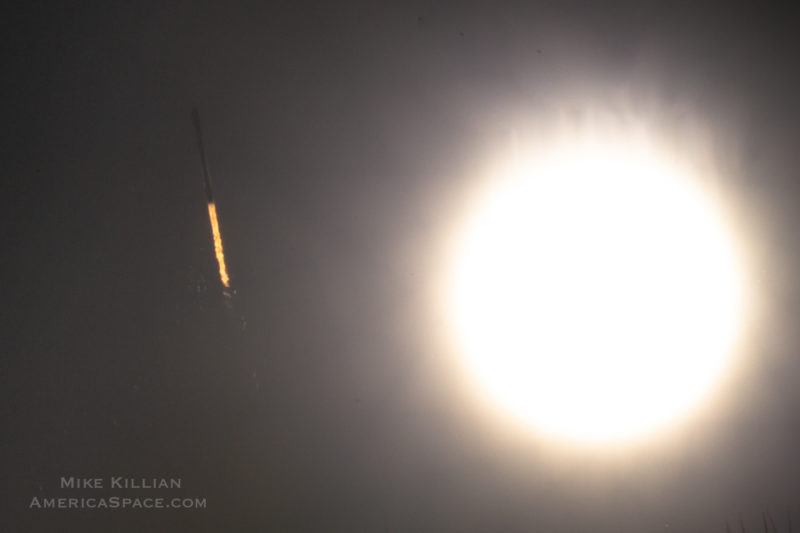
After almost two years, SpaceX successfully passed the magical number of 1,000 Starlinks launched to orbit today, when the veteran B1051 core—the first Falcon 9 to record an eighth launch—roared aloft from historic Pad 39A at the Kennedy Space Center (KSC) in Florida, carrying a 60-strong “batch” of these flat-packed internet communications satellites. With today’s launch, 1,013 production-design Starlinks have been put into orbit since May 2019.
Following a 24-hour postponement from Monday, due to unfavorable weather in the recovery zone, B1051 again broke the shackles of Earth at 8:02 a.m. EST, creating a new record of less than 38 days between flights by the same orbital-class booster. A little more than an hour later, her payload triumphantly delivered to orbit, B1051 was bobbing serenely on the deck of the Autonomous Spaceport Drone Ship (ASDS), “Just Read the Instructions”, with high hopes that a ninth mission might not be too far off.
Less than three weeks into the New Year, it could hardly be imagined that SpaceX would already have bounded out of the starting-gate to set a new raft of personal-best records for its venerable Falcon 9 booster fleet. After all, 2020—despite the traumatic impact of the COVID-19 coronavirus pandemic, the ravages of Mother Nature in the form of multiple Atlantic hurricanes and several agonizing technical issues—proved the most productive year to date for the Hawthorne, Calif.-headquartered launch services organization.
Eleven Falcon 9 cores supported a phenomenal 26 missions and saw individual boosters fly fifth, sixth and seventh voyages to space with record-breaking turnaround times.
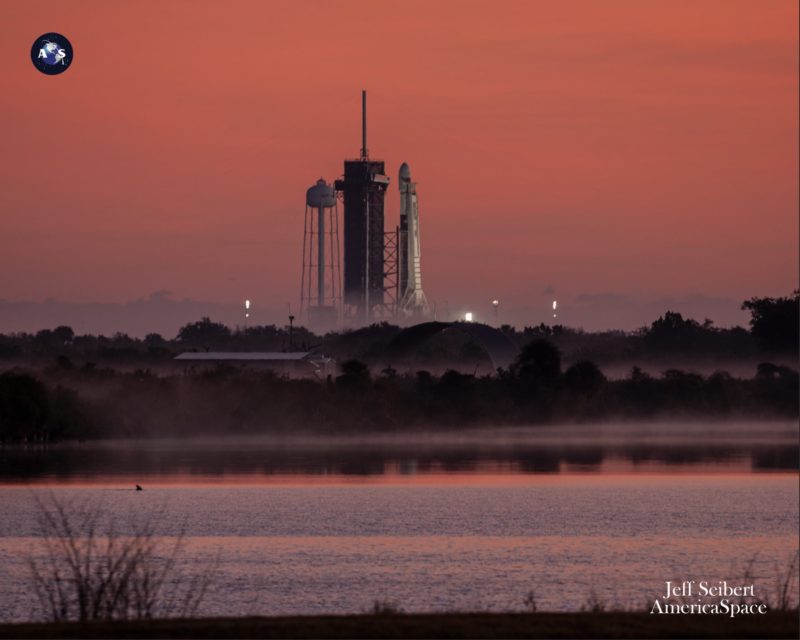
Early Wednesday, the veteran B1051 core became not only the inaugural Falcon 9 first stage to log an eighth mission, but also cemented its credentials for the shortest ever turnaround between two flights by the same booster.
And B1051’s credentials are nothing if not impressive. First launched in March 2019 to deliver an unpiloted Crew Dragon vehicle to the International Space Station (ISS) for the critical Demo-1 mission in support of the Commercial Crew Program, it went on to loft Canada’s three-spacecraft Radarsat Constellation Mission (RCM) the following June. Those first two missions saw B1051 fly both from Pad 39A at the Kennedy Space Center (KSC) in Florida and from Space Launch Complex (SLC)-4E at Vandenberg Air Force Base, Calif.
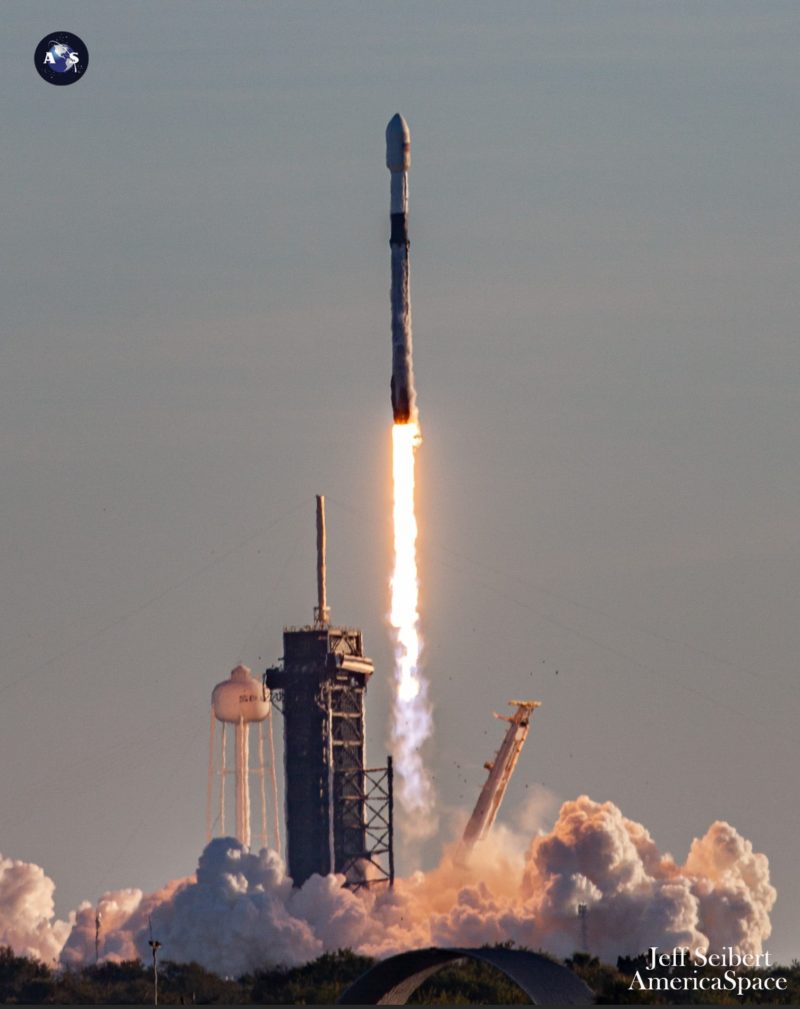
Following her stint on the West Coast, she returned east to fly no less than five missions between January and December 2020, delivering 237 Starlinks and SiriusXM’s SXM-7 high-powered radio broadcasting satellite aloft. In doing so, B1051 became the first Falcon 9 booster to launch both four times and five times in a single calendar year. She also earned an additional accolade on her April 2020 Starlink mission by eclipsing the United Launch Alliance (ULA) Atlas V as the most-flown operational U.S. launch vehicle.
All told, and counting this morning’s safe flight, B1051 has returned to Earth to complete seven Autonomous Spaceport Drone Ship (ASDS) landings and one touchdown on solid ground at Vandenberg’s Landing Zone (LZ)-4.
Having flown her most recent trek to deploy SXM-7 on 13 December, today’s launch marked a little less than 38 days between two missions by the same Falcon 9 core. That achievement soundly surpasses her sister B1058, which logged 51 days—and broke a turnaround record for an orbital-class booster which extended right back to the pre-Challenger shuttle era—between two missions last summer.

Original plans called for the mission to fly on Monday morning, but SpaceX opted for a 24-hour postponement. “Due to unfavorable weather conditions in the recovery area,” it noted in a Sunday evening update, “now targeting Tuesday, 19 January, at 8:23 a.m. EST for launch of Starlink.” This was later moved to No Earlier Than (NET) 8:02 a.m. EST Wednesday, 20 January, in response to the need for “additional time for pre-launch inspections”.
In the meantime, last week the ASDS “Just Read the Instructions” put to sea from Port Canaveral for her eighth Falcon 9 “catch” since being reassigned to support East Coast recovery operations last summer.

Laden with a 60-strong “batch” of Starlinks (all fitted with “VisorSat” optical-darkening technology to limit their visibility in the night sky and corresponding impact upon ground-based astronomy), this morning’s launch—literally—catapults B1051 into second place behind her frequently-flown sister B1049 for the highest number of these flat-packed internet communications satellites placed into orbit by a Falcon 9 core.
B1049 has lifted 298 Starlinks on five missions between May 2019 and last November, with B1051 sitting just one behind with a highly respectable 297. Add to that list Demo-1, the RCM triplets and a pair of imaging satellites for Spaceflight Industries, Inc., and B1051 has launched more than three hundred primary payloads into space in less than two years.
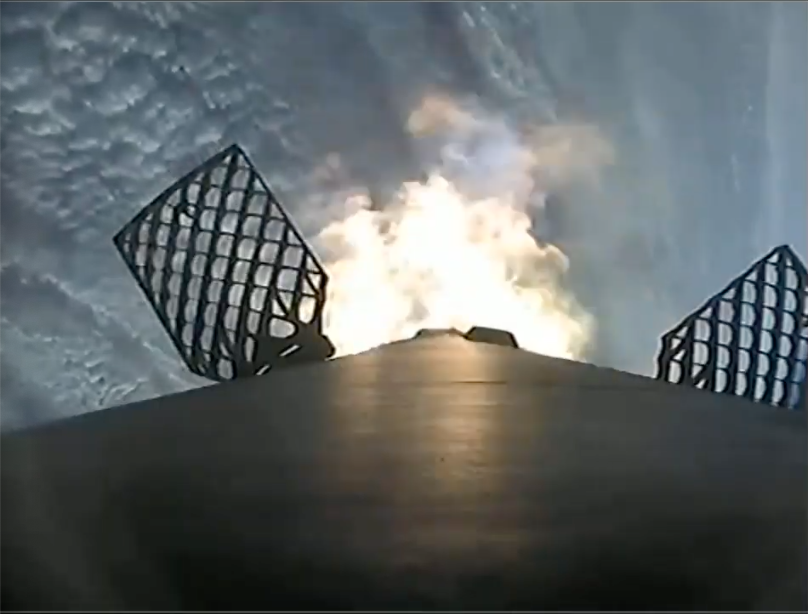
This morning’s launch preparations visibly entered high gear around 35 minutes before T-0, when the sequence to fuel the Falcon 9 with liquid oxygen and a highly refined form of rocket-grade kerosene (known as “RP-1”) got underway. Liftoff at 8:02 a.m. EST was picture-perfect as B1051 became the first Falcon 9 core to log an eighth mission and secured a new record of less than 37 days and 20 hours since its last launch.
As planned, B1051’s nine Merlin 1D+ engines burned for 2.5 minutes, before the core was jettisoned to begin its descent back towards the Atlantic Ocean. And waiting for it, 390 miles (630 km) off Cape Canaveral, was JRTI. With seven pinpoint ASDS touchdowns now under its belt, B1051 ties with sister B1049 for the greatest number of Falcon 9/droneship “slam-dunks”.
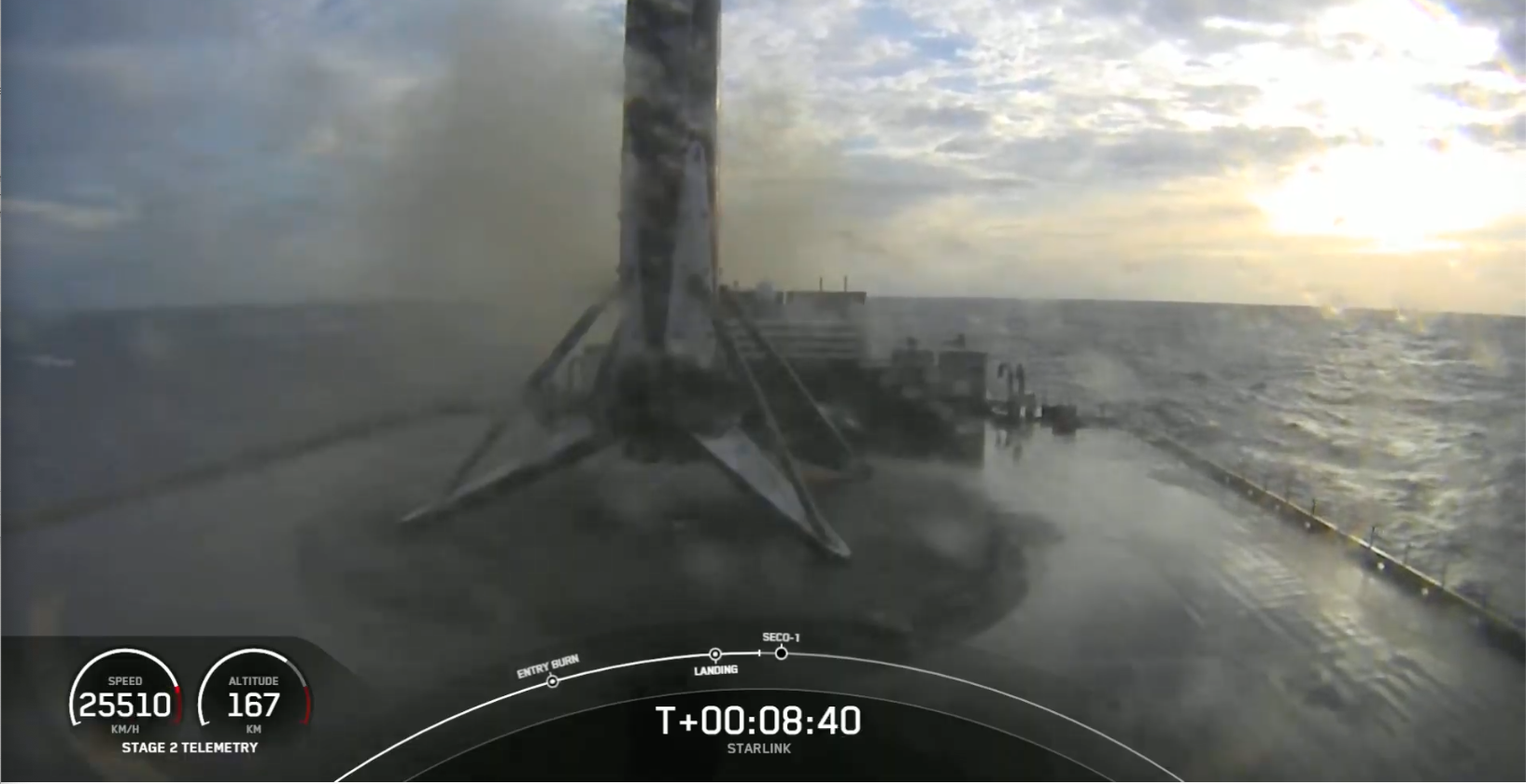
A six-minute “burn” by the single Merlin 1D+ Vacuum engine of the second stage delivered the latest batch of Starlinks smoothly into orbit, positioning them for deployment a little more than an hour after leaving KSC. All told, in 17 launches by seven boosters between May 2019 and today, a grand total of 1,013 production-design Starlinks have been placed into orbit. They form part of a $10 billion program, unveiled by SpaceX CEO Elon Musk in Seattle, Wash., in January 2015, with an expectation that they will revolutionize the provision of low-cost broadband internet services.
Mr. Musk identifies Starlink as a means of opening the way for competitively-priced services for urban regions and rural and underserved areas of the United States. Under the announced plans, an eventual constellation of 12,000 satellites could handle up to half of all backhaul communications traffic and a tenth of all local internet traffic in high-population-density cities by the middle of the current decade.

Late in 2016, SpaceX described the concept as “non-geostationary” and revealed that Starlink’s initial coverage would span the Ku-band and Ka-band regions, between 12-18 GHz and 26.5-40 GHz, respectively. By the late spring of the following year, plans were laid for a second orbital “shell” of satellites to utilize the V-band at 40-75 GHz, which is not routinely used for commercial communications purposes.
Previously, the V-band has seen service for millimeter-wave radar research and scientific applications, but it reportedly also has promise for high-capacity terrestrial millimeter-wave communications networks.
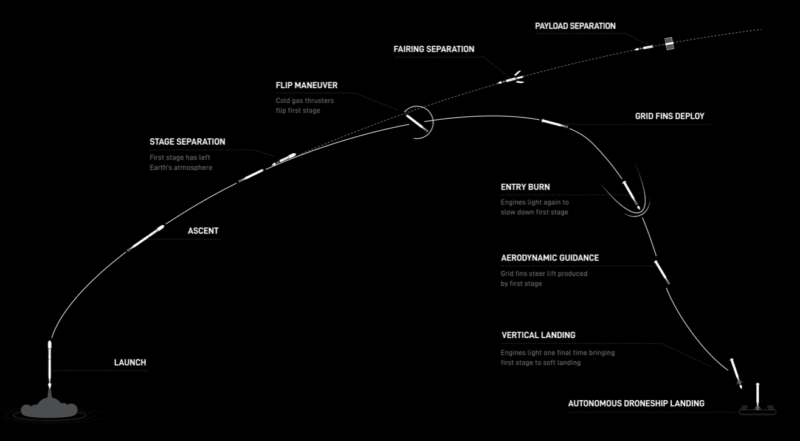
SpaceX’s original intent was for 4,425 Ku-/Ka-band Starlinks to reside at an altitude of 710 miles (1,150 km) and 7,518 V-band birds to sit at 210 miles (340 km), producing a total population of these small satellites by the mid-2020s. However, in November 2018 SpaceX received licensing from the Federal Communications Commission (FCC) to operate a third of the Ku-/Ka-band complement—some 1,584 satellites—at just 340 miles (550 km), much lower than initially planned.
This will produce a relatively short operational lifetime of around five years, before they are maneuvered into a disposal orbit for controlled re-entry. SpaceX has explained that all satellite components are “100-percent demisable” and exceed “all current safety standards”, but the sheer volume of Starlinks to be launched in a relatively short period has aroused lingering controversy, both in terms of the work of astronomers and adding to ongoing debate about the effect of space debris.
.
.
FOLLOW AmericaSpace on Facebook and Twitter!
.
.
Missions » Commercial Space » Starlink »



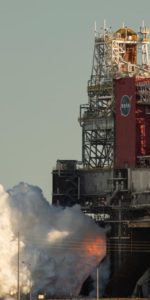

4 Comments
4 Pings & Trackbacks
Pingback:SpaceX Launches Starlink-17, Lands Now 8x-Flown Rocket
Pingback:Falcon 9 Marks 4th Launch in Four Months With Midnight Starlink Mission
Pingback:Historic Cape Launch Pad Observes 125th Launch With First 10x-Flown Falcon 9 « AmericaSpace
Pingback:Historic Cape Launch Pad Observes 125th Launch With First 10x-Flown Falcon 9